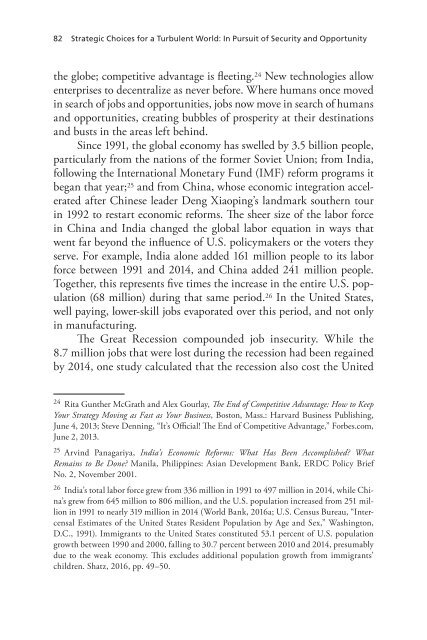Create successful ePaper yourself
Turn your PDF publications into a flip-book with our unique Google optimized e-Paper software.
82 Strategic Choices for a Turbulent World: In Pursuit of Security and Opportunity<br />
the globe; competitive advantage is fleeting. 24 New technologies allow<br />
enterprises to decentralize as never before. Where humans once moved<br />
in search of jobs and opportunities, jobs now move in search of humans<br />
and opportunities, creating bubbles of prosperity at their destinations<br />
and busts in the areas left behind.<br />
Since 1991, the global economy has swelled by 3.5 billion people,<br />
particularly from the nations of the former Soviet Union; from India,<br />
following the International Monetary Fund (IMF) reform programs it<br />
began that year; 25 and from China, whose economic integration accelerated<br />
after Chinese leader Deng Xiaoping’s landmark southern tour<br />
in 1992 to restart economic reforms. The sheer size of the labor force<br />
in China and India changed the global labor equation in ways that<br />
went far beyond the influence of U.S. policymakers or the voters they<br />
serve. For example, India alone added 161 million people to its labor<br />
force between 1991 and 2014, and China added 241 million people.<br />
Together, this represents five times the increase in the entire U.S. population<br />
(68 million) during that same period. 26 In the United States,<br />
well paying, lower-skill jobs evaporated over this period, and not only<br />
in manufacturing.<br />
The Great Recession compounded job insecurity. While the<br />
8.7 million jobs that were lost during the recession had been regained<br />
by 2014, one study calculated that the recession also cost the United<br />
24 Rita Gunther McGrath and Alex Gourlay, The End of Competitive Advantage: How to Keep<br />
Your Strategy Moving as Fast as Your Business, Boston, Mass.: Harvard Business Publishing,<br />
June 4, 2013; Steve Denning, “It’s Official! The End of Competitive Advantage,” Forbes.com,<br />
June 2, 2013.<br />
25 Arvind Panagariya, India’s Economic Reforms: What Has Been Accomplished? What<br />
Remains to Be Done? Manila, Philippines: Asian Development Bank, ERDC Policy Brief<br />
No. 2, November 2001.<br />
26 India’s total labor force grew from 336 million in 1991 to 497 million in 2014, while China’s<br />
grew from 645 million to 806 million, and the U.S. population increased from 251 million<br />
in 1991 to nearly 319 million in 2014 (World Bank, 2016a; U.S. Census Bureau, “Intercensal<br />
Estimates of the United States Resident Population by Age and Sex,” Washington,<br />
D.C., 1991). Immigrants to the United States constituted 53.1 percent of U.S. population<br />
growth between 1990 and 2000, falling to 30.7 percent between 2010 and 2014, presumably<br />
due to the weak economy. This excludes additional population growth from immigrants’<br />
children. Shatz, 2016, pp. 49–50.




